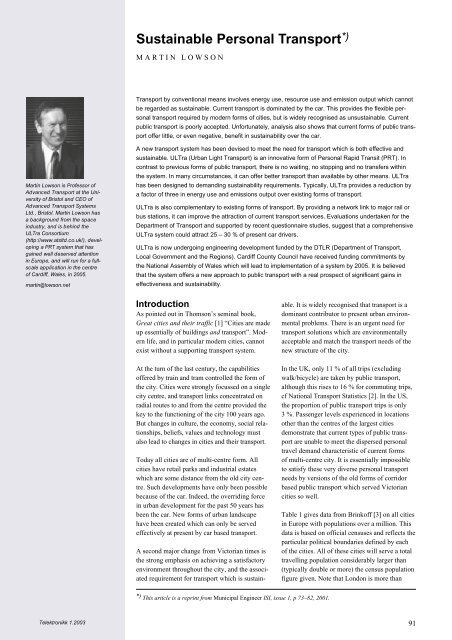Intelligent Transport Systems - Telenor
Intelligent Transport Systems - Telenor
Intelligent Transport Systems - Telenor
Create successful ePaper yourself
Turn your PDF publications into a flip-book with our unique Google optimized e-Paper software.
Martin Lowson is Professor of<br />
Advanced <strong>Transport</strong> at the University<br />
of Bristol and CEO of<br />
Advanced <strong>Transport</strong> <strong>Systems</strong><br />
Ltd., Bristol. Martin Lowson has<br />
a background from the space<br />
industry, and is behind the<br />
ULTra Consortium<br />
(http://www.atsltd.co.uk/), developing<br />
a PRT system that has<br />
gained well deserved attention<br />
in Europe, and will run for a fullscale<br />
application in the centre<br />
of Cardiff, Wales, in 2005.<br />
martin@lowson.net<br />
Telektronikk 1.2003<br />
Sustainable Personal <strong>Transport</strong> *)<br />
MARTIN LOWSON<br />
<strong>Transport</strong> by conventional means involves energy use, resource use and emission output which cannot<br />
be regarded as sustainable. Current transport is dominated by the car. This provides the flexible personal<br />
transport required by modern forms of cities, but is widely recognised as unsustainable. Current<br />
public transport is poorly accepted. Unfortunately, analysis also shows that current forms of public transport<br />
offer little, or even negative, benefit in sustainability over the car.<br />
A new transport system has been devised to meet the need for transport which is both effective and<br />
sustainable. ULTra (Urban Light <strong>Transport</strong>) is an innovative form of Personal Rapid Transit (PRT). In<br />
contrast to previous forms of public transport, there is no waiting, no stopping and no transfers within<br />
the system. In many circumstances, it can offer better transport than available by other means. ULTra<br />
has been designed to demanding sustainability requirements. Typically, ULTra provides a reduction by<br />
a factor of three in energy use and emissions output over existing forms of transport.<br />
ULTra is also complementary to existing forms of transport. By providing a network link to major rail or<br />
bus stations, it can improve the attraction of current transport services. Evaluations undertaken for the<br />
Department of <strong>Transport</strong> and supported by recent questionnaire studies, suggest that a comprehensive<br />
ULTra system could attract 25 – 30 % of present car drivers.<br />
ULTra is now undergoing engineering development funded by the DTLR (Department of <strong>Transport</strong>,<br />
Local Government and the Regions). Cardiff County Council have received funding commitments by<br />
the National Assembly of Wales which will lead to implementation of a system by 2005. It is believed<br />
that the system offers a new approach to public transport with a real prospect of significant gains in<br />
effectiveness and sustainability.<br />
Introduction<br />
As pointed out in Thomson’s seminal book,<br />
Great cities and their traffic [1] “Cities are made<br />
up essentially of buildings and transport”. Modern<br />
life, and in particular modern cities, cannot<br />
exist without a supporting transport system.<br />
At the turn of the last century, the capabilities<br />
offered by train and tram controlled the form of<br />
the city. Cities were strongly focussed on a single<br />
city centre, and transport links concentrated on<br />
radial routes to and from the centre provided the<br />
key to the functioning of the city 100 years ago.<br />
But changes in culture, the economy, social relationships,<br />
beliefs, values and technology must<br />
also lead to changes in cities and their transport.<br />
Today all cities are of multi-centre form. All<br />
cities have retail parks and industrial estates<br />
which are some distance from the old city centre.<br />
Such developments have only been possible<br />
because of the car. Indeed, the overriding force<br />
in urban development for the past 50 years has<br />
been the car. New forms of urban landscape<br />
have been created which can only be served<br />
effectively at present by car based transport.<br />
A second major change from Victorian times is<br />
the strong emphasis on achieving a satisfactory<br />
environment throughout the city, and the associated<br />
requirement for transport which is sustain-<br />
*) This article is a reprint from Municipal Engineer ISI, issue 1, p 73–82, 2001.<br />
able. It is widely recognised that transport is a<br />
dominant contributor to present urban environmental<br />
problems. There is an urgent need for<br />
transport solutions which are environmentally<br />
acceptable and match the transport needs of the<br />
new structure of the city.<br />
In the UK, only 11 % of all trips (excluding<br />
walk/bicycle) are taken by public transport,<br />
although this rises to 16 % for commuting trips,<br />
cf National <strong>Transport</strong> Statistics [2]. In the US,<br />
the proportion of public transport trips is only<br />
3 %. Passenger levels experienced in locations<br />
other than the centres of the largest cities<br />
demonstrate that current types of public transport<br />
are unable to meet the dispersed personal<br />
travel demand characteristic of current forms<br />
of multi-centre city. It is essentially impossible<br />
to satisfy these very diverse personal transport<br />
needs by versions of the old forms of corridor<br />
based public transport which served Victorian<br />
cities so well.<br />
Table 1 gives data from Brinkoff [3] on all cities<br />
in Europe with populations over a million. This<br />
data is based on official censuses and reflects the<br />
particular political boundaries defined by each<br />
of the cities. All of these cities will serve a total<br />
travelling population considerably larger than<br />
(typically double or more) the census population<br />
figure given. Note that London is more than<br />
91
















